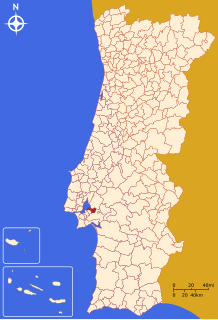
Back ألكوشيتشي Arabic الكوشيتشى ARZ Alcochete Catalan Алкошети CE Alcochete (munisipyo) CEB Alcochete (Município) German Alcochete Esperanto Alcochete Spanish Alcochete Basque آلکوشاچی Persian
Alcochete | |
|---|---|
 View of the old part of the city of Alcochete. | |
 | |
| Coordinates: 38°45′N 8°58′W / 38.750°N 8.967°W | |
| Country | |
| Region | Lisbon |
| Metropolitan area | Lisbon |
| District | Setúbal |
| Parishes | 3 |
| Government | |
| • President | Fernando Pinto (PS) |
| Area | |
• Total | 128.36 km2 (49.56 sq mi) |
| Population (2011) | |
• Total | 17,569 |
| • Density | 140/km2 (350/sq mi) |
| Time zone | UTC+00:00 (WET) |
| • Summer (DST) | UTC+01:00 (WEST) |
| Local holiday | Saint John June 24 |
| Website | http://www.cm-alcochete.pt |
Alcochete (Portuguese pronunciation: [alkuˈʃetɨ] ⓘ) is a municipality in Portugal. The population in 2011 was 17,569,[1] in an area of 128.36 km².[2] The municipality is composed of three parishes and is located in Setúbal District.
Alcochete is known for its bullfighting tradition and its proximity to the second-longest bridge in Europe, the Vasco da Gama Bridge.
The actual site of present-day Alcochete was already occupied during Roman times with a clay production facility. Its name is thought to derive from the Arabic word for oven for reasons not yet understood. It became a vacation site preferred by the Portuguese royalty and the future king D. Manuel I was born in the village. It has experienced major development due to the construction of the Vasco da Gama Bridge.
On 10 January 2008 Portuguese prime minister José Sócrates announced that Alcochete had been selected as the site of the new airport serving Lisbon, Portugal's capital.[3] The location of Alcochete as the construction site of the future Lisbon Airport was confirmed by the Portuguese Government on May 8, 2008.[4]
Sporting Clube de Portugal has a football training facility (Academia Sporting in Alcochete), which accommodated Portugal during the Euro 2004 competition.
- ^ Instituto Nacional de Estatística
- ^ "Áreas das freguesias, concelhos, distritos e país". Archived from the original on 2018-11-05. Retrieved 2018-11-05.
- ^ Portugal's new Lisbon airport to be built in Alcochete for 4.9 bln eur - PM from Forbes online, January 10, 2008
- ^ Portal do Governo

